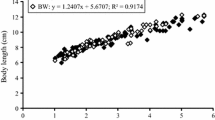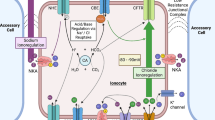Summary
Daily intramuscular injection of cortisol (4 mg kg−1 body weight) in rainbow trout,Salmo gairdneri, for 10 days caused significant increases in the number and individual apical surface area of gill chloride cells per mm2 of filament epithelium. Concomitantly, whole body influxes of sodium (Na+) and chloride (Cl−) increased. Acute (3 h) intra-arterial infusion of cortisol did not affect whole body Na+ or Cl− influx. A significant correlation was observed between both Na+ and Cl− influxes and the fractional apical surface area of filament chloride cells in control, sham (saline-injected) and experimental (cortisol-injected) fish. The chloride cells displayed similar ultrastructural modifications in trout undergoing cortisol treatment as in trout transferred to ion-deficient water. These findings suggest the existence of structure/function relationships in which branchial chloride cell morphology is an important determinant of Na+ and Cl− transport capacity. We conclude that chronic cortisol treatment enhances whole body Na+ and Cl− influxes by promoting proliferation of branchial chloride cells. The results of correlation analysis indicate that the chloride cell is an important site of NaCl uptake in freshwater rainbow trout.
Similar content being viewed by others
References
Avella M, Masoni A, Bornancin M, Mayer-Gostan N (1987) Gill morphology and sodium influx in the rainbow trout (Salmo gairdneri) acclimated to artificial freshwater environments. J Exp Zool 241:159–161
Avella M, Bornancin M (1988) A new analysis of ammonia and sodium transport through the gills of the freshwater rainbow trout (Salmo gairdneri). J Exp Biol 142:155–175
Chakraborti PK, Chakraborti A, Weisbart M (1985) A high affinity cortisol receptor in the gill of the brook trout,Salvenillus fontinalis. Am Zool [Abstr] 25:82
Chan DKO, Chester Jones I, Henderson IW, Rankin JC (1967) Studies on the experimental alteration of water and electrolyte composition in the eel (Anguilla anguilla L.). J Endocrinol 37:297–317
Decourt C, Lahlou B (1986) In vitro studies on the release of cortisol from interrenal tissue in trout (Salmo gairdneri) II Action of changes in extracellular electrolytes. Comp Biochem Physiol 85A:747–753
Dejours P (1988) Respiration in water and air: Adaptation- regulation-Evolution. Elsevier, Amsterdam
Epstein FH, Cynamon M, McKay W (1971) Endocrine control of Na-K-ATPase and seawater adaptation inAnguilla rostrata. Gen Comp Endocrinol 48:425–431
Evans DH (1984) The roles of gill permeability and transport mechanisms in euryhalinity. In: Hoar WS, Randall DJ (eds) Fish Physiology. vol XB, New York, Academic Press, pp 239–283
Henderson IW, Chester Jones I (1967) Endocrine influences on the net extrarenal fluxes of sodium and potassium in the European eel (Anguilla anguilla L.). J Endocrinol 37:319–325
Hirano T, Utida S (1968) Effects of ACTH and cortisol on water movement in isolated intestine of the eel, (Anguilla japonica). Gen Comp Endocrinol 11:373–380
Kaisling B (1985) Structural adaptation to altered electrolyte metabolism by cortical distal segments. Fed Proc 44:2710–2716
Lahlou B (1980) Les hormones dans l'osmoregulation des Poissons. In: Ali MA (ed) Environmental Physiology of fishes. Nato Series, New York London Plenum, pp 201–240
Laurent P (1984) Gill internal morphology. In: Hoar WS, Randall DJ (eds) Fish Physiology. vol XA, New York, Academic Press, pp 73–183
Laurent P (1989) Gill structure and function: fish. In: Wood SC (ed) Comparative pulmonary physiology, New York, Marcel Dekker, pp 69–120
Laurent P, Dunel S (1980) Morphology of gill epithelia in fish. Am J Physiol 238:R147-R159
Laurent P, Hobe H, Dunel-Erb S (1985) The role of environmental sodium chloride relative to calcium in gill morphology of freshwater salmonid fish. Cell Tissue Res 240:675–692
McDonald DG, Rogano MS (1986) Ion regulation by the rainbow trout,Salmo gairdneri, in ion poor water. Physiol Zool 59:318–331
Madsen KM, Tisher CC (1983) Cellular response to acute respiratory acidosis in rat medullary collecting duct. Am J Physiol 245:F670-F679
Madsen KM, Tisher CC (1984) Response of intercalated cells of rat outer medullary collecting duct to chronic metabolic acidosis. Lab Invest 51:268–276
Maetz J (1956) Les échanges de sodium chez le poissonCarassius auratus L. Action d'un inhibiteur de l'anhydrase carbonique. J Phys Paris 48:1085–1099
Mattheij JAM, Stroband HWJ (1971) The effects of osmotic experiments and prolactin on the mucus cells in the skin and the ionocytes in the gills of the teleostCichlasoma biocellatum. Z Zellforsch Mikrosk Anat 121:93–101
Mayer N, Maetz J, Chan DKO, Forster ME, Chester Jones I (1967) Cortisol, a sodium excreting factor in the eel (Anguilla anguilla L.) adapted to seawater. Nature 214:1118–1120
Mazzone RW, Kornblau S, Durand CM (1980) Shrinkage of lung after chemical fixation for analysis of pulmonary structurefunction relations. J Appl Physiol: Resp Environ Exerc Physiol 48(2):382–385
Perry SF, Laurent P (1989) Adaptational responses of rainbow trout to lowered external NaCl concentration: contribution of the branchial chloride cell. J Exp Biol (in press)
Perry SF, Wood CM (1985) Kinetics of branchial calcium uptake in the rainbow trout: effects of acclimation to various external calcium levels. J Exp Biol 116:411–433
Sandor T, DiBattista JA, Medhi AZ (1984) Glucocorticoid receptors in the gill tissue of fish. Gen Comp Endocrinol 53:353–364
Smith LS, Bell GR (1964) A technique for prolonged blood sampling in free swimming salmon. J Fish Res Board Canada 21:711–717
Steinmetz PR (1986) Cellular organization of urinary acidification. Am J Physiol 251:F173-F187
Stetson DL, Steinmetz PR (1983) Role of membrane fusion in CO2 stimulation of proton secretion by turtle bladder. Am J Physiol 245:C113-C120
Rahim SM, Delaunoy JP, Laurent P (1988) Identification and immunocytochemical localization of two different isoenzymes in teleostean fish erythrocytes and gill epithelia. Histochemistry 8:451–459
Wolf K (1963) Physiological salines for freshwater teleosts. Prog Fish Cult 25:135–140
Author information
Authors and Affiliations
Rights and permissions
About this article
Cite this article
Laurent, P., Perry, S.F. Effects of cortisol on gill chloride cell morphology and ionic uptake in the freshwater trout,Salmo gairdneri . Cell Tissue Res. 259, 429–442 (1990). https://doi.org/10.1007/BF01740769
Accepted:
Issue Date:
DOI: https://doi.org/10.1007/BF01740769




